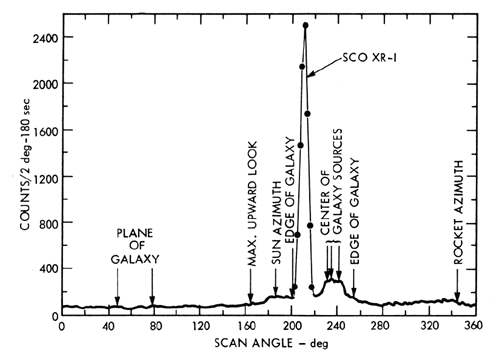Early Observation of Sco X-1
Sco X-1, the first cosmic X-ray source (other than the Sun) ever detected, was discovered on June 18, 1962 by a team led by Riccardo Giacconi. His Aerobee rocket flight, launched to look for X-rays from the Moon, discovered Sco X-1. It wasn't until 1966 that an accurate location of the x-ray source was obtained and the unusual nature of Sco X-1 was made clear. In every square degree of the sky, there are about one hundred stars visually brighter than Sco X-1. But in X-rays, it dominates the sky. Most imaging X-ray instruments do not look at Sco X-1, as it degrades detectors due to its X-ray brightness. Image Caption: Three minutes of data from a rocket-born X-ray detector flown in October 1967. This shows the counting rate of the detector as it scanned a great circle containing the source Sco X-1 and a cluster of sources in the direction of the galactic center. The detector field of view was 5x30 degrees. The Sun was below the horizon. Image and caption from Exploring the X-ray Universe (Charles & Seward)
IMAGES |
By Mission |
Stars |
HEASARC Home | Observatories | Archive | Calibration | Software | Tools | Students/Teachers/Public Last modified: Thursday, 26-Jun-2003 13:48:45 EDT |


